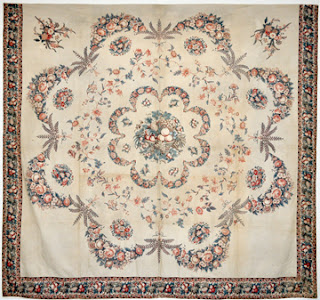Just when you think that there are no more good quilts to buy you get a note from somebody like WillyWonky who tells you he just found a probable Achsah Wilkins spread online a couple of weeks ago.
Now you may not know what an Ascsah Wilkins quilt is, so I will summarize it.
Achsah Goodwin Wilkins of Baltimore is thought to have supervised an applique coverlet workshop in the early 19th century. When Dr. William Rush Dunton was researching Baltimore quilts in the 1930s and '40s he came across a group of Broderie Perse bedspreads that were attributed to Wilkins, although she was not known to sew, as she had limited use of her hands.
She was a slaveholder and it is very possible that she organized enslaved or paid seamstresses to stitch these spreads. Dr. Dunton found 13 of them to picture in black and white in his 1945 book Old Quilts.
Read more here at my early quilts blog:
http://quilt1812warandpiecing.blogspot.com/2012/06/cut-out-chintz-swags-in-rococo-style.html
Bill's is similar to this pair but it's apparently a 14th example that Dunton didn't include.
I really know very little about these spreads. The person who does is Ronda McAllen who will be giving a lecture on Friday November 9th at Colonial Williamsburg titled "The Chintz Gardens of Achsah Goodwin Wilkins."
Well now that you know what it is you can eat your hearts out along with me and a few others who need to work on our character.
We do have the consolation that it is in a good home. A fine collection.
And Bill said he is going to bring it to the American Quilt Study Group seminar in Lincoln, Nebraska this week to share it.
Read one of Bill's posts here:
http://willywonkyquilts.blogspot.com/2012/09/lets-compare.html
See the auction notice here
http://www.liveauctioneers.com/item/12859657_floral-broderie-perse-applique-bedspread-probab
Floral "Broderie Perse" Applique Bedspread, probably 19th century, chintz applique with blue and red floral design on textured ivory cotton ground, approx. 9 ft. 2 in. x 10 ft. 2 in.
For more information about the Colonial Williamsburg conference "Influences on American Quilts: Baltimore to Bengal" click here:
http://www.history.org/history/institute/institute_about.cfm
And for more about the American Quilt Study Group Seminar click here:
http://www.americanquiltstudygroup.org/seminar.asp







You must have a GREAT system to keep track of all the different links to similar topics.... sure enjoyed this group .....now when you all decide why Bill's item has no yellow I sure hope you "report". Thanks for the new pieces to the puzzle.
ReplyDeleteLack of yellow: Bill hypothesized a different colorway; Merikay hypothesized fading---natural yellows often fugitive. I listen to them.
ReplyDeleteBarbara:
ReplyDeleteI would like to get the quilt name and designer for one of the pictures on your blog. Please contact me at: pegclark@truman.edu
Thanks!
Peggy Clark
Kirksville, MO
A small group of us viewed the quilt together this afternoon, and the consensus was that the yellows likely faded. It does look faded, but I still wonder about colorways. One of my little projects will be to play with it in Photoshop to see if a layer of yellow would make that image look more like the full color chintz with the inclusion of orange and green, made by laying yellow over the red and blue.
ReplyDeleteGreat to meet you, Barbara! Thank you for this blog and everything else you do. :)